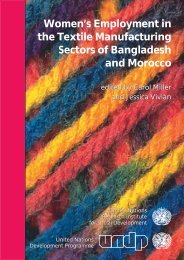RESEARCH REPORT 4 Paid Care Workers in Tanzania:
RESEARCH REPORT 4 Paid Care Workers in Tanzania:
RESEARCH REPORT 4 Paid Care Workers in Tanzania:
You also want an ePaper? Increase the reach of your titles
YUMPU automatically turns print PDFs into web optimized ePapers that Google loves.
<strong>Tanzania</strong> had only 9,093 nurses out of the needed 14,743 hence generat<strong>in</strong>g a gap of 38.3%<br />
mak<strong>in</strong>g <strong>Tanzania</strong> the 165 th country <strong>in</strong> the world <strong>in</strong> terms of the ratio of nurses per population.<br />
(www.parliment.go.tz/bung/doc/afya. The WHO Country Health System Fact Sheet 2006 for<br />
<strong>Tanzania</strong> records that the nurs<strong>in</strong>g density per 1000 population was 0.37 (World health<br />
Statistics 2006 www.who.<strong>in</strong>t/whosis/en/ ). All <strong>in</strong> all, there is clearly a shortage of the nurs<strong>in</strong>g<br />
cadre.<br />
There is also geographical variation <strong>in</strong> terms of nurse: population ratio. The 2005 report from<br />
one district council (Morogoro) revealed that the ratio of nurses to population was 1: 888,<br />
while for general physicians it was 1:290,316 and for Assistant Medical Officers (AMOs) it<br />
was 1:6,598. (URT: 2006: pg.5). In an <strong>in</strong>terview with a retired nurse, we were <strong>in</strong>formed that a<br />
maternity w<strong>in</strong>g <strong>in</strong> the Kilimanjaro Christian Medical Centre (KCMC), a faith-based hospital<br />
which acts as a referral hospital, has not been opened for one year now s<strong>in</strong>ce completion<br />
because of shortages of nurs<strong>in</strong>g staff (<strong>in</strong>terview <strong>in</strong> 2008).<br />
Despite the shortage of nurs<strong>in</strong>g cadre, the tra<strong>in</strong><strong>in</strong>g of nurses for all levels lags beh<strong>in</strong>d the<br />
needs for this cadre. From 2002 to 2007 for <strong>in</strong>stance, the number of nurses graduat<strong>in</strong>g<br />
annually from tra<strong>in</strong><strong>in</strong>g <strong>in</strong>stitutions <strong>in</strong>creased from 910 to 4,000 for diploma holders and from<br />
469 to 13,791 for certificate holders. This <strong>in</strong>crease has not bridged the resource gaps with<strong>in</strong><br />
the nurs<strong>in</strong>g cadre.<br />
Services rendered by the health sector are hierarchically provided. In the health pyramid, a<br />
nurse is considered as a skilled worker occupy<strong>in</strong>g the lowest position <strong>in</strong> the skill hierarchy of<br />
the health workers. While the tra<strong>in</strong><strong>in</strong>g of a nurse focuses more on patient care, due to human<br />
resource crisis <strong>in</strong> the health sector, nurses f<strong>in</strong>d themselves do<strong>in</strong>g multiple tasks <strong>in</strong>clud<strong>in</strong>g<br />
those which they were not tra<strong>in</strong>ed for. In an <strong>in</strong>terview, a programme officer of the<br />
Reproductive Health Programme with UNFPA, who had previously worked as a nurse for<br />
n<strong>in</strong>e years, said that “nurses are multi tasked, at one time they take the role of doctors, as they<br />
diagnose and prescribe medic<strong>in</strong>e, they also act as cleaners as they are expected to jo<strong>in</strong> the<br />
semi-skilled staff <strong>in</strong> general cleanl<strong>in</strong>ess of the facility, while at other times, they act as<br />
messengers as they have to deliver health equipment and materials <strong>in</strong>clud<strong>in</strong>g HIV &AIDS<br />
kits, drugs, and other equipment to the lower level health facilities. Those who have not<br />
tra<strong>in</strong>ed as midwives f<strong>in</strong>d themselves do<strong>in</strong>g midwife tasks if posted <strong>in</strong> areas where there is no<br />
midwife or when faced with a neighbour who is deliver<strong>in</strong>g at home”.<br />
In the cont<strong>in</strong>uum of care, the nurses offer skilled support to the community-based health<br />
workers who <strong>in</strong> turn support the primary care givers. Some of the nurses attend to the needs of<br />
HIV&AIDS patients <strong>in</strong> a health facility, others supervise the programne from a health<br />
facility, some of them are based <strong>in</strong> a primary health facility <strong>in</strong> which case they are expected to<br />
supervise the non-health staffs who are volunteers, and others are volunteers who have retired<br />
from their nurs<strong>in</strong>g career. As supervisors they also provide counsel<strong>in</strong>g, prescribe ARVs,<br />
follow up patients at home to ensure adherence to requirements, as well as compile reports for<br />
the program. The nurs<strong>in</strong>g cadre is hence critical <strong>in</strong> the cont<strong>in</strong>uum of care. They perform these<br />
tasks under very tough work<strong>in</strong>g conditions which are further elaborated <strong>in</strong> the follow<strong>in</strong>g<br />
section of this paper.<br />
The patient care tasks which <strong>in</strong>clude bath<strong>in</strong>g a sick person, <strong>in</strong>clud<strong>in</strong>g clean<strong>in</strong>g of those who<br />
vomit or have diarrhea, car<strong>in</strong>g for TB patients, as well as clean<strong>in</strong>g and dress<strong>in</strong>g wounds<br />
subject nurses to the danger of <strong>in</strong>fections. . The Service Provision Assessment (ORC<br />
Macro/NBS/TACAID: 2007) revealed that health workers <strong>in</strong> both government, private, faith<br />
based <strong>in</strong>stitutions were subjected to “hospital acquired <strong>in</strong>fection” due to lack of <strong>in</strong>fection<br />
control facilities. The <strong>Tanzania</strong> Service Provision Survey (2006) revealed that out of the<br />
6
















